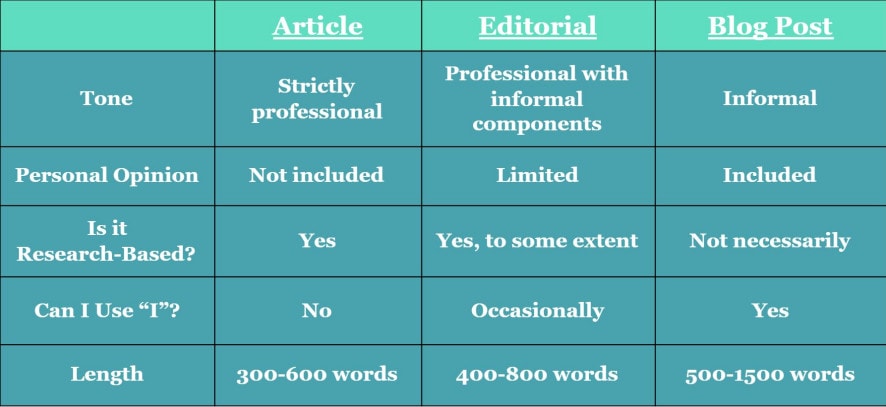Typically, online publishers such as Kingdom Winds will organize their posts by content genre rather than by nonfiction genre. This is to provide topic organization for readers since they browse by subject matter instead of word count. For a writer, however, understanding the piece’s genre guidelines is as essential as pinpointing a thesis.
The terms “article,” “editorial,” and “blog post” are used interchangeably despite their differencing features. Simple, but important, writing questions like “Can I use the word ‘I’?” or “Roughly how long should it be?” are answered once a writer understands his piece’s writing family.
Take a look at the chart below to understand subtly crucial characteristics:

For example, articles are based on concrete events, people, and places. Your mission as the writer is to be an efficient reporter instead of an elaborate storyteller. Good examples include Becca James’s film review “Nothing Is Impossible When Mary Poppins Returns,” or Rachael Weisinger’s news article “Lauren Daigle’s Rolling Success.” Both articles are concise, hyperlinked to original sources, and generally representative of a broader audience. While there is some verbiage to indicate an opinion, it is reflective of general impressions rather than based on individualistic thoughts.
In comparison, the editorial genre allows for a more personal opinion to drive the content. These can be the most confusing to decipher because they may include individual references, but the post’s focus is not on the writers themselves. Model texts include Jennifer Quinn’s “The Most Volatile Topic Around: Vaccines” and Shawn Hunting’s “The Flag, Kneeling, and a Kingdom Mindset.” Both editorials subjectively analyze a notion or idea instead of objectively synthesizing its existence.
Lastly, blog posts are the most versatile in length and tone. They intentionally read like a conversation between the writer and the reader due to the writer’s transparency. In both Kassi Russell’s “Killing What Almost Killed Me” and Maranda Dawn King’s “Feel the Feels,” the reader is fixed on a personal story. Hyperlinks may be necessary, considering the sources a writer may reference. However, a blog is essentially a reflection of the individual and his/her thoughts, which may or may not address the outside world.
At the end of the writing process, you may find that your post tiptoes across genre guidelines. That’s fine in certain circumstances as long as a piece is better produced with various characteristics. In general, however, make sure you’re writing is clearly differentiated between a formal piece, a general dialogue, and an authentic memory. This structure supports your subject matter and keeps your reader engaged.
To read more genre writing examples or to join the Kingdom Winds Collective to submit your own work, visit our website online.
Featured Image by John Schnobrich




 Gluten-Free Mac and Cheese
Gluten-Free Mac and Cheese  Breakthrough: Enneagram Coaching With Sue Mohr
Breakthrough: Enneagram Coaching With Sue Mohr  How Do You Get Ideas
How Do You Get Ideas